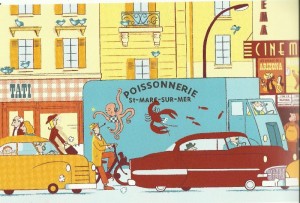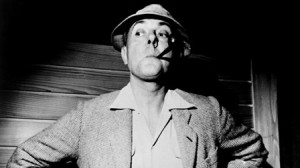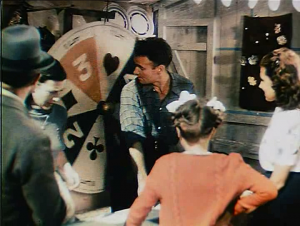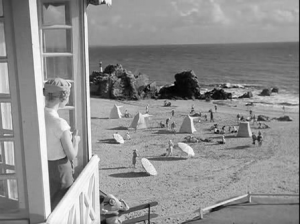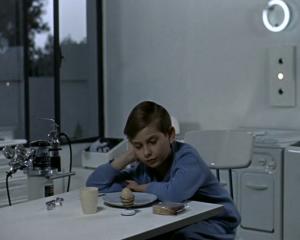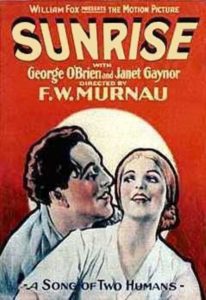 Another silent film from 1927, Sunrise: A Song of Two Humans is directed by F.W. Murnau and starred George O’Brien and Janet Gaynor. It was adapted from the short story “The Excursion to Tilsit” by Carl Mayer and went on to win two of the first Academy Awards, both Best Actress and Best Cinematography. At this point, I’m beginning to think of Janet Gaynor as my 1920s bae.
Another silent film from 1927, Sunrise: A Song of Two Humans is directed by F.W. Murnau and starred George O’Brien and Janet Gaynor. It was adapted from the short story “The Excursion to Tilsit” by Carl Mayer and went on to win two of the first Academy Awards, both Best Actress and Best Cinematography. At this point, I’m beginning to think of Janet Gaynor as my 1920s bae.
Sunrise: A Song of Two Humans
Luckily for me, Sunrise was also available on YouTube which I noticed after it appeared on my “Recommended for you” videos. I was initially worried since I remember reading that the film’s negatives were destroyed in a fire and that it might be one of those “lost” films, but luckily someone was able to make a copy for the masses to enjoy. It was a lazy Sunday afternoon when I began this movie about a sordid affair between a married farmer, The Man, and a floozy, The Woman from the City.
Right away, I was stunned with how hot George O’Brien was- A touch of Ryan Gosling mixed with Chris Evans. His character lacked any sort of spine and had zero concern for his wife, but his trysts with a pretty flapper from the city on vacation were saucy, and it wasn’t long until she pleaded with him to go back with her. While he objects because he has a wife, Margaret Livingston’s lustful city girl demeanor gets dark as she encourages The Man to kill his wife. “Just take her out for a boat ride and throw her over,” she coos at him. The Man’s faces are perfection during this scene, as are the dialogue cards while he struggles with what do. Cue the perfect, delicate flower that is Janet Gaynor as she agrees to a boat ride with the husband she loves dearly while the town’s old maids gossip about how unhappy their marriage is. Surely this is a chance for them to reconnect! Her happiness is beyond infectious as she all but skips to meet her husband for their daylight boat ride, but it’s not long as she realizes something is afoot. The acting is just phenomenal as The Man’s inner struggle comes to a head and he cannot bring himself to toss out his dear wife.
While F.W. Murnau’s sets aren’t particularly laden with details, his direction, especially with the lighting details, adds much to the atmosphere between characters. It’s also worth it to note this is the first time where the camera is in motion during a film, and at times it’s shaky, but a different touch from “7th Heaven.” The moviefone score was perfect. It crescendos at the most romantic of moments between our main characters, and added a blissfully sinister overtone to the early interactions between The Man and The Wife.
While I felt every second of the movie, my favorite scene is where The Man takes The Wife and kisses her good and well. It’s a dizzying, beautiful kiss, as they cause traffic jams, scenery to change, and it’s like the whole span of their love exists in just those few moments. It’s a fucking beautiful piece of film.
Sunrise: A Song of Two Humans was enjoyable, but as the pacing felt slow in places, I’m not sure it’s one I’d watch again. You can definitely find the film on Amazon or at your local video store!
SCreenings is a series of movie diaries from our staff, currently being monopolized for the daunting task of watching every Oscar nominee by one of our editors
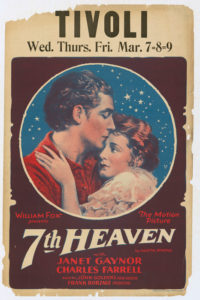 Initially released in 1927 as a silent film based on a play, “7th Heaven” was among the nominees for the first ever Academy Awards for Best Picture. While it didn’t win, it made it’s mark on cinematic history. Starring Janet Gaynor and Charles Farrell, who went on to become America’s Lovebirds, and directed by Frank Borzage, the film did score awards for Best Director, Best Actress, and Best Writing.
Initially released in 1927 as a silent film based on a play, “7th Heaven” was among the nominees for the first ever Academy Awards for Best Picture. While it didn’t win, it made it’s mark on cinematic history. Starring Janet Gaynor and Charles Farrell, who went on to become America’s Lovebirds, and directed by Frank Borzage, the film did score awards for Best Director, Best Actress, and Best Writing.
7th Heaven
I should begin by saying the only silent film I can remember seeing is “Nosferatu,” which renders my expertise in this genre of movie completely nonexistent. I had no idea what to expect from a vintage story at 1:00 AM on a Monday, but as someone who enjoys the experience of a movie, I can say with certainty that there is a certain kind of magic here.
I watched Janet Gaynor’s petite and classically beautiful Diane live a miserable life at the hands of her abusive sister only to be left for dead when the devastatingly handsome Chico, played by Charles Farrell, intervenes. Like seriously, if you had told me I would be lusting for a man who has long since left this world, whose very existence I JUST learned about…well, I’d probably believe you! His tussled hair and strong face probably set many hearts aflame in the twenties! I’m assuming Diane and her bitch sister were “ladies of the evening,” based solely on a couple of vague context clues. Honestly, I’m unsure where they found money to live if they weren’t selling themselves in 1920’s era Paris. Either way, the slow buildup between Diane and Chico was touching, and the ending devastating, demonstrated by the large amounts of tissues I filled with the tears of my ugly sobs. My expectations were low, and to say this movie went above and beyond is an understatement.
Diane’s development from a timid waif to a strong willed person in charge of her own destiny was beautiful, and I found it very interesting that she was the one who inspired Chico to be okay with his feelings, and she was the one providing the backbone to this couple. Gaynor’s range of emotion for Diane is really something to behold. I genuinely can’t wait to see more of her acting. Chico also undergoes a character transformation. His first appearance shows him to be haughty, and proud of his disbelief in “Bon Dieu,” much to the chagrin of the local priest, but with a yearning to be more than a lowly sewer cleaner. It’s only through his relationship with Diane that he sees that there could be more to life than a bitter disregard for everything.
I am pretty sure there are a couple other Frank Borzage directed movies on my list, and if his eye for storytelling remains just as wonderfully paced and framed, I’m really in for a treat. My favorite, favorite scene has to be where Chico leads Diane up seven flights of stairs to his heaven, a rooftop apartment. Borzage’s set allowed the vertical use of a camera in order to shoot the ascension of the stairways in one take and it made such an impression on me. It was romance at its finest as Chico shows Diane the view, delivering an iconic line:
“I work in a sewer but I live near the stars.”
I would absolutely watch this movie again, if just to dream about star crossed lovers. I found the movie on YouTube, but it’s also available on DVD, unless you wanna spring for an expensive ass box set with a bunch of 1920’s films on it!
SCreenings is a series of movie diaries from our staff, currently being monopolized for the daunting task of watching every Oscar nominee by one of our editors
Happy Summer! It’s time for the first of my Summer Film Showcases! These are things that make me happy; and I want to share them with you!
Mid-20th Century French film director and actor Jacques Tati is one of my favorite movie makers ever and his offbeat, often nostalgic but also critical approach to cinema and the summer-y and idealistic atmosphere in at least 3 of his films makes his work a perfect summer film showcase. If you’re a film enthusiast and know of Tati, you’ll know what I mean. If not, I’m so excited to introduce you to him and his films as well as his continued legacy.
Tati, born Jacques Tatischeff (his family was of Russian nobility descent, go figure) is known for his ridiculously short filmography; he directed 9 films, only 6 of them feature films. He has more writing credits to his name as well, but he’s mostly known as being the writer/director/actor to his films. At first a writer and comedic actor specializing in sporty mime in the 1930’s, he later fell into directing and Tati gained attention for his short film “L’Ecole des facteurs” (“The School for Postmen”) in 1947.
Tati’s films are unique in that they are mostly dependent on visual comedy and sight gags. They’re not silent films per se, as there is often a little dialogue, but it’s often only background chatter and atmospheric sounds. And music of course. Often comical. In a way his films more accurately continue the tradition of silent cinema comedy, whilst being neither a silent nor an actual dialogue laden film. 2/3rds of the Disney/Pixar film Wall-E (2008), sans the later involvement of the speaking human characters and computer, actually fits into this category of visual comedy. It’s the genre of non-silent, silent film.
Jour de fete, filmed in 1947 and released in 1949 was his first feature film. Starring Tati himself as a bumbling and easily distracted postman in rural France, the film shows the postman’s daily routine as he gets distracted, particularly by the local traveling country fair and his later crusade to emulate the (then efficient) United States postal service. The film was meant to be in color; in fact intended to be the first French film to be in color; but due to issues all over the board it wasn’t to be, ultimately. The released black-and-white version actually has bursts of color hand painted by Tati himself in the film, but there is also a restored color version, which is charming (and the version I watched). This film starts to set up themes and conventions you see in later films; namely warm affection for rural or “old” pre-war France, and how individuals are struggling to keep up with modernity. This one has more dialogue than his later films.
The big part of this showcase are my two favorite films of his; Les Vacances de Monsieur Hulot (Mr. Hulot’s Holiday) (1953) and Mon Oncle (My Uncle) (1958)
Les Vacances, his second feature film,is the breeziest of Tati’s works; droll and effervescent, it’s summer personified. I had the pleasure of actually watching this for the first time while I was at the beach myself and so watched it with lingering smells of actual sunscreen and salt about the place; so dab on sunscreen while watching this! (btw there’s actually a perfume based on this film! It smells like petrol, sun lotion and sea salt.)
Shot in black and white, this is a beautiful on location depiction of the French Saint-Marc-sur-Mer region in the Loire Atlantique. This film introduces Tati’s alter ego, the naive and socially awkward, pipe smoking gentlemen Mr. Hulot as he takes an August holiday to the beach. The film is just, so lovely. Full of sight gags, wonderfully composed shots and a chill jazz score by Alain Romans, the film is nostalgic, sweet and yet a little biting. There is some social class parody and criticism here, particularly making fun of capitalists, young Marxist-type intellects and stuffy upper class people all of whom can’t seem to ever relax. It definitely fits within Tati’s preoccupation to criticize the shift from “old” France and enjoying simple things to the Post-War “work” consumerism. The masquerade party scene in particular is striking in it’s gentleness and yet bittersweet criticism of people. It’s one of my favorite films.
His next one, Mon Oncle is in glorious color. I’ve written about it before, but it stands as my favorite. Monsieur Hulot returns, this time with his family. Hulot is the odd ball bachelor and favored uncle to nine-year-old Gérard (Alain Becourt), who lives with his parents, M. and Mme. Arpel (Jean-Pierre Zolla, Adrienne Servantie) in a new Americanized, modernized and completely sterile monstrosity of a neighborhood. Hulot lives in a small apartment in the older more run down (and at the time being torn down) section of town; which clings to a more rustic and old fashioned way of life. Tati continues his “fish out of water” in regards to Hulot trying to exist (and failing) within modern sterile materialism and dealing with how impersonal his family has become.
There is a slightly more enforced plot here than the loosely structured Vacances; Gérard, bored with his life, adores and hangs out with his uncle as much as possible, accompanying him in various outings and pulling pranks on adults with his school friends. Meanwhile Mme. Arpel is bent on getting her “wayward” brother Hulot a job and make him more appropriate for their social sphere so they strive to get him a position at M. Arpel’s plastic hose factory. Mayhem ensues. A lot of this humor and criticisms of impersonality, especially when raising children, can be still applied to today. To get a taste for the film check out the infamous “kitchen scene” here. There’s a lot of heart in this film, and it too is one of my favorites. 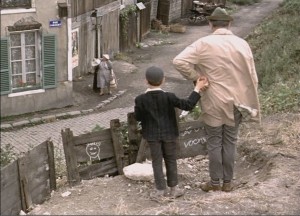 The movie is visually beautiful and unique, dogs pepper the film as they run about the neighborhoods.
The movie is visually beautiful and unique, dogs pepper the film as they run about the neighborhoods.
The character of Monsieur Hulot returns in two more Tati films; Play Time (1967) and Trafic (1971). Play Time itself a force to be reckoned with so I will feature them in their own feature later in the summer.
Mr. Hulot additionally lives on in other mediums; an unproduced script was turned into the animated film The Illusionist (2010) with the lead based on Tati himself.
Additionally, french artist David Merveille with perennial favorite NorthSouth books has additionally released just last summer the amazing picturebook Hello Mr. Hulot a book full of gorgeous illustrations featuring the clumsy Mr. Hulot as we view different visual scenarios, often with a touch of the whimsical or outlandish and continue the tradition of Tati’s physical comedy quite well. 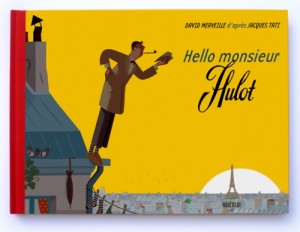 And it’s great to see such a legacy be kept alive through a medium that can fully embrace what Tati did in his films. Snappy, bright colors and a fine balance between modernism and Tati’s mid-century work. I think the book deserves a place on any film buff’s shelf, and for anyone who appreciates good design.
And it’s great to see such a legacy be kept alive through a medium that can fully embrace what Tati did in his films. Snappy, bright colors and a fine balance between modernism and Tati’s mid-century work. I think the book deserves a place on any film buff’s shelf, and for anyone who appreciates good design.
You can buy these films and Hello Mr. Hulot! on Amazon or Netflix or check your local bookstores!
- Hardcover: 32 pages
- Publisher: NorthSouth; First American Edition edition (September 1, 2013)
- Language: English
- ISBN-10: 0735841357
- ISBN-13: 978-0735841352
- Product Dimensions: 9 x 10.9 x 0.4 inches
max@sub-cultured.com
Twitter: @maxlikescomics
This week I am offering up a classic film for witty younger kids, older kids, and adults and seniors that were formerly kids; Howard Hawks’ 1938 screwball comedy Bringing Up Baby. If you like deep plots, character motivations and subdued humor; well this isn’t the movie for you. Over the top, exhaustively quick paced, rapid-fire dialogue and cartoony Looney Tunes-esque personalities and gags, as well as real leopards and dogs running amok make up the entirety of this zany film.
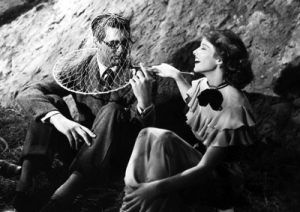
One of the many scenes where the actors more or less ad-lib their scene and are on the verge of breaking.
SUPER DUPER QUICK HISTORY LESSON:
The genre of slapstick and screwball comedy pulled from the physical comedy of silent film of the 1910’s and 20’s and subsequently has roots in vaudeville and stretching further back to comedy of manners plays which in various forms through the years itself reaches back to Ancient Greece. People have always loved to laugh. Especially if it’s extremely physical and over the top. The screwball comedy reached its peak during the 1930’s, petering out in the early 40s. A lot of the conventions or tropes the genre brought however have been continued to be utilized in comedy films since; they just don’t take it as extreme, with notable exceptions of course. Bringing Up Baby while not that succcessful when first released has in retrospect been held in high regard as a quintiscential example of the genre and is overall much liked today. And you should like it too.
THE OVERALL GIST:
Bringing Up Baby is simply about a mild-mannered paleontologist named David (played by Carry Grant) who whilst in the midst of assembling, after five years of hard work, a complete brontosaurus skeleton (barring one bone that is coming in the mail) and a pending marriage to a dour fiance is suddenly whisked into a series of misadventures with the capricious and manic socialite Susan Vance (Katherine Hepburn) he meets on a golf course. Said adventures are mostly centered around or involving a tame pet leopard named Baby and Susan dragging David across the Connecticut countryside (after what I dare you to guess). It’s a terribly good, sometimes exhausting romp to watch as no character is particularly normal or realistic. Everything is in hyperbole. Characters interrupt each other and keep talking causing a cacophony of chatter. Katherine Hepburn’s character keeps or rather steers the entire ship (even if that means sailing the ship right towards the rocks) so it’s not surprising to learn the script was more or less tailored for her.
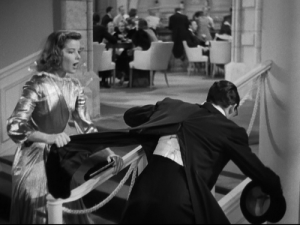
It gets worse.
I love the film and it has enough sight gags such as ripped dresses showing underwear, slipping, tripping, breaking things, people falling into water,just plain crazy situations that could in theory I think hold the attention of younger kids who would most likely laugh at many of the antics and the delivery of lines than truly understanding them. So perhaps try watching it with someone a bit younger, it’s by no means a child’s film but a family could easily enjoy this.
While speaking about content Bringing Up Baby is notable in that Carry Grant famously is forced to wear a women’s robe in one scene and ad-libs a line that many think is one of the first “mainsteam” uses of the word “gay” (certainly in a Hollywood film) as a possible reference to homosexuality rather than the, at the time, general usage meaning “genial” and “fun” or “happy”. The term has been noted to have already been used underground by the homosexual community since at least the 1920s and in pornography but did not really become common in the mainstream public vernacular with that context until nearly fifty years later, long after the film. If that was indeed the intended meaning of Carry’s ad-lib the film then marks a relatively important point in gay culture history in American pop-culture.
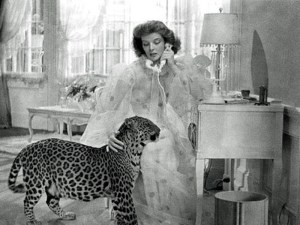
I really can’t think of anything to say for this image. Sort of self explanatory…
OVERALL VERDICT
Zany. Over the top. But oh so right, I love the film despite that in a lot of ways as a lot of all movies it is very outdated and not without its problems though in some of its stereotypes and other choices (the most likely dubious treatment of the animal actors) which of course reflect on the era. The movie was called already at times cliched back in 1938 by reviewers but I feel a lot of situations that are commonplace today in comedy films and other movie conventions really date back more or less to this film (one look at the brontosaurus and you know what’s going to happen to it right?)
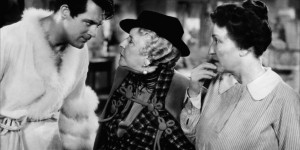
The infamous robe scene.
There is also of course the debate about Susan Vance.
A SUSAN VANCE ADDENDUM: Is she A MPDG?
So cartoonish, effervescent, manic and scheming is Susan Vance and the things she employs to harass and manipulate the rather hapless David (more or less because she decided that she fancied him) with little indication of any other wants or desires has in the past made film critic Nathan Rabin point out her character as a notable “early” example of the Manic Pixie Dream Girl trope (a character type he coined) in film. That is she solely exists to “change” the main character or tend to his needs.
But wait! Don’t let this turn you off from it!I call false. I call “NO!”
Well sort of. It can go in a lot of directions. I can certainly see why she would be called as such. I can see the complaint. However while she ends up providing David with, in retrospect the “funnest day of his life”, I personally did not see any particular lessons being actively taught through her in showing David how to live life or trying to bolster his spirit but rather more or less just claiming him as her own and dragging him around doing her thing until he basically caught up. He did change but it not seem her intent was to change him at all, rather just keep him.
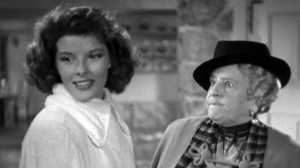
Any particular reason she wants to marry him? Nada. Any declaration that she will change him in order to do so or what she wants to see from him? Not that I remember other than saying he’s much better looking without his glasses. Does she silently work her schemes? No, in fact she outright says ” No, I know that I’m gonna marry him. He doesn’t know it but I am.” That sounds to me an awfully like a valid and very firm want. It’s limited, but it’s still a want.
Is the fact she announced the intent better than say passively not saying it? A little bit. It is fair and a valid complaint for people to wish more for female characters to have roles other than wanting the male lead and stop being more or less being used as a prop for said lead. Big yes. Can Susan be replaced with a sexy lamp in this film? No. Big no. Is it better that she voiced her want clearly as opposed to characters who do not? I think so. Hell, I myself as a playwright know the problem of not wanting to create one dimensional characters, particularly women. It’s not hard, but this movie is not trying too hard to really paint a picture of a realistic or real narrative.
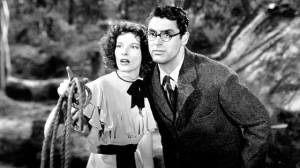
“We’ah huntin’ leopards”
But Susan doesn’t come off to me as an “ideal” or a idea of a woman. She is too ridiculous, too in-story obnoxious in a film where everyone is ridiculous to be taken too seriously. For her to be the only thing scoffed as fluff as if no one else in the film was equally fluff (and oh boy are they) is in itself crazy. Her motivations (which do extend to getting the leopard safely kept somewhere until she figures out what to do with it) concerning David for me ring as pretty valid within the context of the film. She’s an entitled upper-class debutante who seems to flit about doing what she does in the film anyway and in a bit of a whimsy claims a guy as her own perhaps deciding at first sight when she steals his golf ball. Where is the line where we dismiss a woman character who maybe, at the moment really only does care about a certain thing (as people can do) in a story this outrageous? The quick designation of women characters at times as Manic Pixie Dream Girls is I think in a way sort of tangled in it’s own version of misogyny. Zoe Kazan, screenwriter and actress (Ruby Sparks) shares a similar position. From an interview with Patti Greco for Vulture.com she commented about Susan Vance:
Well, yeah, there’s a line in the movie that basically questions the idea of manic pixie dream girls: “The quirky, messy women whose problems make them appealing are not real.”
Sure. What bothers me about it is I think that women get described that way, but it’s really reflective of the man who is looking at them, and the way that they think about that girl. Not about who that girl really is or what her personality actually is. I think that to lump together all individual, original quirky women under that rubric is to erase all difference. Like, I’ve read pieces that describe Annie Hall as a manic pixie dream girl. Katharine Hepburn in Bringing Up Baby. To me, those are fully fledged characters that are being played by really smart actresses. I just think it’s misogynist. I don’t want that term to survive. I want it to die.
Susan knows what she wants and David, while a funny choice (Carry’s passive and bespeckled David is notably the inspiration for Christopher Reeves’ iteration of Clark Kent in Superman) is still a choice and she doesn’t outright try to change him to make him happier. She is also incredibly flawed, a compulsive liar which they acknowledge and she is well aware of her hysterical nature and uses it on purpose. She’s devious. In fact Katherine Hepburn’s turn as the non-stop quipping, teasing, scheming and play acting Susan serves more like a trickster archetype; a skinny silk-covered Bugs Bunny to the bewildered David’s Elmer Fudd. Stirring up chaos for the sake of chaos. I like Susan. Could she exist really outside of this movie? Probably not. Or for that matter neither can any of the characters in this film. Nor Bugs Bunny.
I can’t give you anything but love, Baby.
Max Eber
Staff Writer/The Doctor
max@ihogeek.com
Twitter: @maxlikescomics
In honor of the Oscars this Sunday, I decided this week to dig up a sunny vintage film to chase away the blues on this wet dreary day. The choice? 1958’s Cary Grant and Sophia Loren’s romantic comedy-drama vehicle Houseboat which was Oscar®-nominated for Best Original Story and Screenplay!
Filmed in color, the film begins with a largely estranged father Tom Winters (Cary Grant) coming from Europe where he conducts business to collect his three children from their Aunt Carolyn’s plush manor on the Chesapeake after the death of his wife, her sister, in an automobile accident. He had been separated from his wife for some time, and had largely been absent from his child’s lives for some three to four years. Since their mother’s death the children have each been exhibiting particular behaviors; David the eldest (played by Paul Petersen who has an uncanny resemblance to Cary Grant) has developed kleptomaniac inclinations, the middle child Elizabeth can’t sleep at night, and the youngest, seven year old Robert has become incredibly sullen, stubborn and developed a liking to playing the harmonica. His proclamation of “I hate everybody. I hate everybody in the whole wide world” in the opening scene while twirling around is both incredibly funny, but also rather heartbreaking.
It is Robert who is truly the most important of all the children; the catalyst in that he runs away from their father after he takes them to Washington DC, and in an attempt to amuse them, takes them to a symphony concert. Robert hides on a row-boat following the concert where Loren’s Cinzia, , the spoiled daughter of that night’s featured conductor subsequently steals to get away from her overbearing and overprotective father. Robert comes out of hiding. While sullen, Robert still hasn’t lost his boyishness and the two shortly become friends and Cinzia eventually returns Robert to his father. Robert wants her to stay as their maid. Tom asks her to be his children’s maid or governess and she rejects the offer, only to return the next morning to accept.
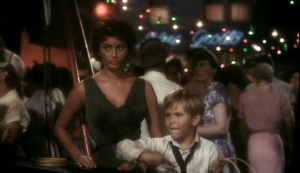
Super endearing. She steals his pizza.
The titular houseboat doesn’t appear until forty minutes into the movie; the family is meant to move into their Aunt Carolyn’s former guest house which was supposed to be moved to a new lot, but it subsequently gets crushed by a train. The inept mover responsible for its destruction, Angelo, offers them the use of the houseboat and that’s where the comedy antics and true love story start to form. The fact the titular plot-device arrives so late in the film is an intriguing decision but one really doesn’t notice its late arrival since the movie is so breezy the pacing doesn’t particularly feel like its been that long.

Yeah stop your tractor right on the train tracks. Nice move Angelo.
The movie is charming watching both the severely tanned Loren and Cary Grant (rather aged and wrinkled) banter and spat with great chemistry and Loren’s natural magnetism. There is no wonder Cary Grant was head over heels in love with her in real life. Compared to modern family and romantic comedy films the film is restrained never quite reaching exaggerated levels of slapstick and bawdiness that one may be used to, but the resulting tone is consistent and butter smooth. While mainly full of fluffy wish fulfillment and what could be seen as upper middle class 1%er “white people problems” the film does have a very realistic side concerning family, trauma and how a parents actions affect children and the mending of that bond. Even the richer Aunt Carolyn is unlucky in love, estranged from her own absent husband whom she does proceed to divorce and her stifled and ultimately unrequited affections for her brother-in-law Tom. The children; David, Elizabeth and Robert are all rather well cast; they look like they could be Cary Grant’s children and while mouthy in that 1950’s child actor way, they don’t appear too artificial unlike other films of the period and are more realistically caustic and have moments of pretty sharp clarity and an honest manner.
Loren is beautiful and charismatic as Cinzia and is amazing with the children. Her relationship with Robert, whom she calls affectionately Roberto is perhaps the true “romance” of the movie, if you can call it that. One forgets Loren was so young in the movie; she and her character where both twenty-two years old. For the modern viewer Cinzia’s dress and composure may seem much older than that, mainly due to societal shifts; girls today are allowed to act much younger and dress much younger and more casual than they were in the 1950’s. By the time you were twenty-two you were certainly firmly an adult.
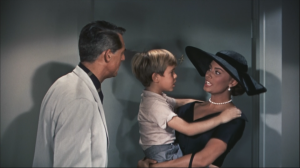
She’s twenty-two. Classy. Classy. But domestically inept.
Regardless if you enjoy refined comedy and romantic comedies or prefer a more kid-friendly family film, you will surely enjoy this film as it can fit the bill for either demographic; it is warm, summery, quirky and charming especially for those who live on the East Coast and know what summers on the Chesapeake and on the Atlantic bays and coasts are like. For those who live land locked; this is a great escapist romp through the Maryland and Virginia maritime. It is perfect for a hot summer evening or like tonight, a cold and dreary one, as it can be either refreshing or utterly warming. Highly recommended! è bello!
Max Eber
Staff Writer/The Doctor
max@ihogeek.com
Twitter: @maxlikescomics







